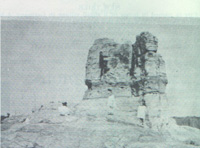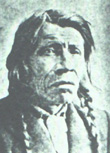The people who inhabited Rice County before the white man came where a tribe of Sioux Indians known as the Wahpekute "Shooters among the leaves", they belonged to a federation of Indian tribes known as the Dakota.

There main settlement was a village located along the northwest shore of Cannon Lake Me-da-te-peton-ka "Lake of the big village". They traveled and lived up and down the Cannon River. The Wahpekute called the river Iyan Bosndata "The Standing Rock River", it was named after the tall white sandstone rock formation downstream, it is located in the City now known as Castle Rock, Dakota County, Minnesota.
The Explorer Joseph N. Nicollet surveyed and maped Southren Minnesota for the United States Goverment and he carved his name and date far upon the rock and he baptized the river as River Aux Canots, because of the Indian canoes he saw parked at the mouth of the river. Later explorers and map makers confused the french word and called it the Cannon River.

Alexander Faribault came to Rice County in 1826, and began trading with the Indians up and down the Cannon. In 1834 he established a permanent trading site, now known as the City of Faribault. In this same year he persuaded the Wahpekute to move there village along the Cannon Lake to the site of Faribault, They set up there dwellings of Bark covered houses and about 40 tepees in an area around present day Division and Fourteen Street's, the year was 1835.
 The Chief at this time was Visiting Eagle, and he was very loyal to Alexander Faribault.
The Chief at this time was Visiting Eagle, and he was very loyal to Alexander Faribault.
In 1849 Congress passed a bill organizing the Territory of Minnesota. All this time the Indians felt themselves to be the real owners of the land. By taict agreement only fur traders licenced by the United States Goverment were permited to operate west of the Mississipi River. The white men needed a treaty "selling the land".
In 1851 the Chief was Hayeetchah Monamie (or Red Legs), and in the same year the treaty of Mendota was signed. Other Sioux Chiefs from the Cannon Valley that were involved with the treaty were, Grey Mane, Pay Day, Scarlet Armour and Red Cloud. Alexander Faribault, along with his Father, Jean Babtist and his brothers Oliver and David were there as interpreters (they were also present at Travese De Sioux-1851).
As a result of the treaty, the Wahpekute lost there rights to the land in Rice and Steele Counties. Most of them were moved to reservations, Crow Creek, Fort Thompson South Dakota, Santee Reservation, Santee Nebraska, Lake Traverse, Sisseton North Dakota, Upper Sioux, Granite Falls Minnesota, Fort Peck Reservation, Poplar Montana. There were some who refused to go to the reservation and remained here living on the land given to them by Alexander Faribault.
There are few reminders of the Native American people whom made this area home. In the Great Sioux Uprising of 1862, Most Sioux were made to leave Minnesota.
Sisseton Wahpeton Sioux Tribe Homepage
History And Culture of the Sisseton-Wahpenton Sioux Tribe
Stills from Dakota Exile
Dakota Exile-Time Line
The Dakota Language Home Page
Back to Rice County Genealogy


© 1999 Shannon Sleeth